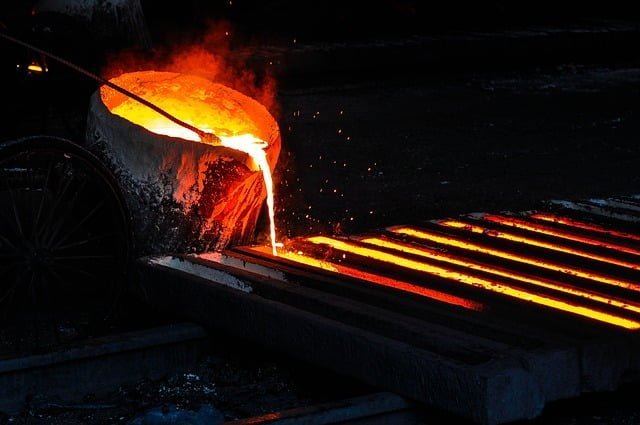Our Exhibitions | Check Full Details Here
Furnaces
Pusher Hearth Type Furnace | Reheating of Billets
Over the last 35 years, ENCON group has established the credentials in designing, manufacturing, installation and commissioning of fuel efficient solutions in the field of heat recovery systems, energy management system, furnaces and allied equipment. ENCON is managed by globally experienced qualified Engineers & Technocrats. Responding to various customers’ feedback, ENCON group’s endeavor is now to supply the wide range of Furnaces in Ferrous and Non ferrous industries.
ENCON group is operating from Faridabad (Head office and Manufacturing unit), Gujarat and Kolkata. ENCON has an independent export activity and is ISO 9001:2008 certified.
Features:
The Pusher hearth type furnace is normally arranged for side or front charging and side or end discharging from the furnace end by extractor.
The Billets will be brought / stored on the charge grate and pushed one by one to the approach charge roller table. Necessary Charge positioning device will be provided to enable the charge to be located in the furnace properly in single or double row. The Billets will be charged in the furnace in single or double row by pushing with suitable hydraulically operated charge pusher mechanism.
In order to achieve better temperature uniformity of the Billets, the furnace will be designed with adequate number of independent thermal control zones. There will be another unfired preheating zone which will act as recuperative zone to preheat cold Billets.
The furnace will be equipped with ENCON burners. These burners will be located on the side or rear wall and can easily handle high air preheat temperature. A convection type multi-tubular recuperator for preheating the combustion air from the flue gas leaving the furnace.
The furnace zone temperature will be automatically controlled through mass-flow based instrumentation. Instrumentation for temperature & pressure as well as control & other safety system are PLC-PC based. Necessary furnace pressure control instruments will be used.
Complete interlocking and sequential control of the furnace will be carried out through Programmable Logic Controller (PLC) with or without any redundancy of the CPU.
| Charge | Billets |
| Grades | Carbon Steels / Low Alloy Steels |
| Charge Length | upto 12,000 mm |
| Furnace | 1250°C ( max.) |
| Firing | BF Gas- / PG – / Mixed Gas- / Natural Gas- / LPG – /Oil fired |
| Furnace Capacity | upto 120 TPH |
Heat Treatment Plants for Annealing Electric Steel
Exclusively in manufacturing of low voltage asynchronous and hermetic motors
Committed to excellence-Increase performance-Drive Innovation-Act responsively -Value People-Attract and empower talent-Customer focused Non-siliconized or low-siliconized semi-finished strip is increasingly used for the manufacture of magnetic cores for electrical equipment. The cores are fabricated from cold rolled strip which undergoes critical deformation after recrystalization and must be annealed after punching. Following annealing, core loss is of an order of 2 to 4 W/kg for a sheet thickness of 0.5 to 0.7mm. Electrical sheet manufactured by this process is superior to dynamo strip not only with regard to cost but also with regard to:
saturation
A.C. premeability
core loss (due to magnetic transformation)
ageing
lamination factor and
the quality of the cutting edges
Appropriate temperature and furnace atmosphere control induces three simultaneous heat-treatment effects needed to fabricate material of the properties required. The hard, fine-grained ferritic structure is transformed into a soft coarse-grained structure according to ASTM series 2½ to 3½. At the same time, the carbon content of the metal is reduced to less than 0.005% to prevent any effect of residual carbon on the properties of the material ageing. Further, an oxide coating is obtained at a temperature of 550°C. Decarburization and plating necessitate permanent contact between the reaction gas and the strip surface. The oil, normally applied prior to punching the laminations, is burnt off in the first heating zone.
| Coe Loss | Unit | After Punching | After Annealing |
|---|---|---|---|
| P1.0 | W/Kg | 8.0-9.5 | 2.9-3.2 |
| P1.5 | W/Kg | 16.5-18.5 | 5.5-7.5 |
| Flux Density | |||
| B 25 | T | 1.45-1.55 | 1.64-1.68 |
| B 50 | T | 1.68-1.70 | 1.74-1.77 |
| Aging | % | 0-2 | 2-3 |
| Carbon Content | % | 0.060-0.080 | 0.003-0.005 |
| Grain Size | ASTM | 8-10 | 2-3 |
| Oxide Layer Thickness | M | 0 | 0.8-1.6 |
| Burr Height | mm | Max 0.05 | Max 0.04 |
| Vickers Hardness HV 5/30 | Kp/mm2 | 130-160 | 60-80 |
| Tensile Strength | N/mm2 | 380-450 | 250-300 |
| Yield Strength | N/mm2 | 3330-360 | 200-250 |
| Elongation | 0% | 15-25 | 25-35 |
Heat Treatment Of Steel Pipes & Rods
Normalising, Soft Annealing, Bright Annealing with or without controlled Atmosphere Encon Group has the requisite expertise and capabilities in developing the creative, economical solutions of furnaces required for heat treatment of pipes, rods and bars. These furnaces can be either Batch or Continuous Roller hearth types with or without protective atmosphere. The Emerging Energy Efficient Furnace Builder & combustion solutions provider
Furnace Types
Furnace for Normalizing ( Recrystallising and Stress Relieving)
Furnace for Spherodising, Soft Annealing
Furnace for Solution Annealing, Hardening, Quenching & Tempering.
Furnace for the bright annealing of refrigerator tubes and braking system pipes
Advantages
High Capacity and easy adaptation of conveyor systems to annealing process
Gas- tight Furnace suitably designed for protective atmospheres.
Low Maintenance requirements
High Furnace availability
Extremely versatile in application
Configuration
A charging table for charge preparation,
A cross conveyor, to transfer the charge to the inlet roller table of the furnace.
A furnace seal system for effective separation of the furnace atmosphere from the ambient air, the direct-fired or indirect-fired furnace with downstream cooling section.
A seal system at the cooling section outlet
An outlet roller table with discharging system
These components can also be installed in a number of other configurations
Features
Single ended Radiant Tube Burners compared to U-type Burners
Individual Ignition Control of every burner
Burner control in On-Off – Round Robin mode versus continuous control.
State of Art PLC and PC – System for Furnace Control
Special selected Refractory
Inlet Table width increases from Inlet Table to Furnace, to Cooling Section to Outlet Table
Separate Cooling water controls for Cooling section walls, roof and waterbox
Sufficient Cross Transfer Table and Roller Spacing to always support tubes
Gear with special transmission ratio allowing even hand movement of furnace roller
Nitrogen supply at Inlet Outlet to put out possible fire





